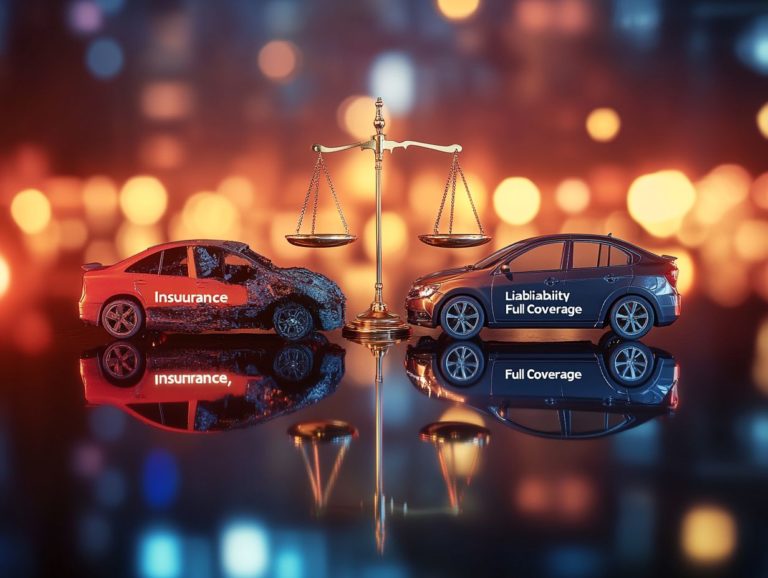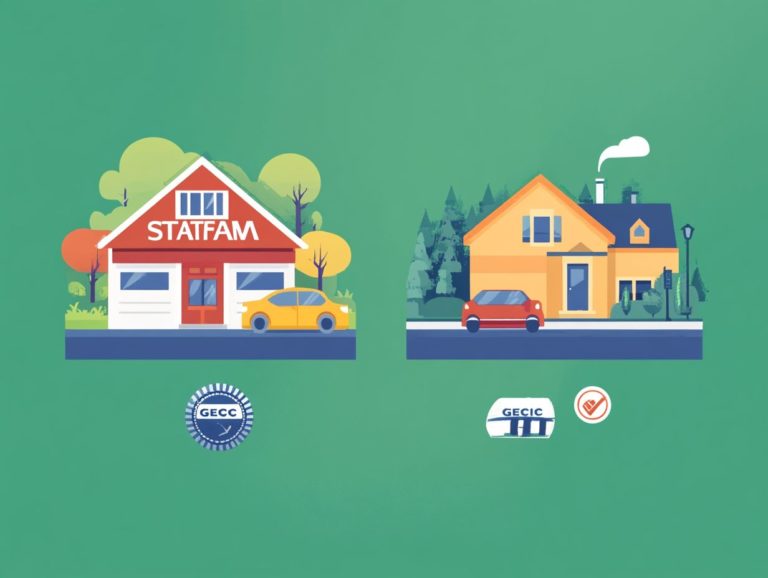Top 5 Factors Affecting Auto Insurance Rates
Navigating the world of auto insurance can feel overwhelming, especially when it comes to understanding what influences your rates. Factors like your age, driving experience, and the type of vehicle you drive are just a few key elements that affect how much you ll pay.
This article delves into the top five factors affecting auto insurance rates, explaining why they matter and what steps you can take to potentially lower your costs. This article also discusses available discounts, the importance of regular policy reviews, and the risks associated with driving without insurance.
Discover insights that can save you big bucks!
Contents
- Key Takeaways:
- 1. Age and Driving Experience
- 2. Driving Record and Claims History
- 3. Type of Vehicle
- 4. Location and Driving Environment
- 5. Credit Score
- Why Do These Factors Affect Auto Insurance Rates?
- Frequently Asked Questions
- What are the top 5 factors that affect auto insurance rates?
- How does my driving record impact my auto insurance rates?
- Why do age and gender play a role in auto insurance rates?
- Does the type of vehicle I drive affect my auto insurance rates?
- How do my coverage and deductibles affect my auto insurance rates?
- Why does location play a role in auto insurance rates?
Key Takeaways:

Your age and driving experience can drastically affect your rates, with younger and less experienced drivers typically paying more.
A clean driving record and a claim-free history can lead to lower auto insurance rates.
The type of vehicle you insure also plays a role in determining your rates. More expensive and high-performance cars often require higher premiums.
1. Age and Driving Experience
Age and driving experience significantly influence your car insurance rates. Insurance companies use these factors to assess risk and tailor policies for different groups of drivers. This shapes your premiums and coverage options.
If you re a younger driver, especially under 25, you may face considerably higher premiums due to a lack of experience and the statistically higher accident rates in this age group. Recent studies show that drivers in this bracket are three times more likely to be involved in a crash compared to their older peers.
On the flip side, if you re a seasoned driver with a clean record, you can benefit from good driver discounts. These rewards acknowledge your safe driving habits and help lower your premiums over time. Such discounts encourage responsible behavior and show how a history of safe driving can positively impact insurance costs, highlighting your commitment to road safety.
2. Driving Record and Claims History
A clear driving record and a positive claims history are essential for securing competitive car insurance rates. Insurance companies closely monitor your traffic violations and accidents to evaluate your risk profile.
By maintaining a clean record, you avoid surcharges and unlock various discounts offered by insurance providers for safe driving behavior. For instance, a clean slate may qualify you for accident forgiveness programs, protecting you from rate increases after your first at-fault accident.
This highlights an important strategy: embracing safe driving habits can significantly affect your future insurance costs. A solid driving history can lead to perks like reduced premiums or enhanced coverage options, reinforcing that responsible driving pays off in multiple ways.
3. Type of Vehicle
The type of vehicle you choose, including the make and model, can significantly affect your auto insurance premiums. Certain vehicles are associated with higher risks of theft, accidents, or repair costs, impacting your coverage options and rates.
For example, SUVs often carry higher premiums than sedans due to their larger size and potential for greater damage in collisions. Conversely, cars like the Honda Accord or Subaru Legacy typically enjoy lower insurance costs because of their strong safety ratings.
In terms of protecting yourself, comprehensive and collision coverage are essential. These policies ensure that no matter what type of vehicle you drive be it an economical hatchback or a luxury SUV you can safeguard yourself against unforeseen incidents or damages that may arise on the road.
4. Location and Driving Environment

The location and driving environment, often determined by your ZIP code, play a crucial role in shaping your auto insurance rates. High auto theft rates or extreme weather can lead to increased insurance premiums.
This discrepancy between urban and rural locales arises from various factors, including crime rates, population density, and the frequency of severe weather events.
Urban areas, typically bustling with a higher number of vehicles and frequent traffic congestion, face an elevated risk of accidents. This risk contributes to higher insurance costs.
On the flip side, rural settings might pride themselves on lower crime rates, but they have their own challenges. Certain regions could experience more frequent hailstorms or flooding, leading to a spike in weather-related claims.
State requirements also play a significant role in determining premium rates. Some states demand more comprehensive coverage, which drives overall costs higher. By understanding these elements, you can better navigate the complexities of auto insurance across different geographical contexts.
5. Credit Score
Your credit score is a crucial factor not related to driving that insurance companies consider when determining your premiums. A poor credit history can result in higher insurance costs and may signal a greater risk of financial turmoil.
Insurers often delve into your credit history to gauge the likelihood of you filing claims. If you have a lower credit score, you may encounter increased premiums due to this perceived risk.
To potentially lower your insurance rates, consider taking the following steps:
- Regularly check your credit reports for errors
- Make timely payments
- Reduce outstanding debts
By establishing a solid payment history and limiting new credit inquiries, you can enhance your score. This proactive approach can lead to more favorable insurance terms and significant financial advantages.
Why Do These Factors Affect Auto Insurance Rates?
Factors such as your age, driving experience, vehicle type, location, and credit history play a significant role in determining your auto insurance rates. To navigate these complexities, consider the top tips for understanding your auto insurance policy. These elements help insurance companies assess the risk of insuring you, ultimately influencing the premiums and coverage options available to you, like liability insurance and comprehensive coverage.
Each of these factors shapes your overall risk profile as a driver. For example, if you re younger, you might face higher premiums due to less experience behind the wheel. If you live in an urban area, insurers may view you as having a greater risk of accidents compared to someone in a rural setting.
The make and model of your vehicle can also affect your rates. Understanding how these factors contribute to your risk can save you money and enhance your coverage!
What Other Factors Can Influence Auto Insurance Rates?
Besides your age and driving experience, various other factors can significantly impact your auto insurance rates, resulting in differing premiums among drivers like you.
Take telematics insurance, for example. This insurance monitors your driving habits through technology everything from your speed and braking patterns to your overall road habits. Insurers analyze this real-time data, which opens the door for potential discounts if you demonstrate safe driving practices, effectively incentivizing better habits behind the wheel.
Your claims history also plays a pivotal role; frequent claims can raise a red flag, indicating a higher risk and leading to increased premiums. Additionally, the environment in which you live whether it’s a bustling urban area prone to accidents or a serene suburb also influences your insurance costs.
Together, these factors create a detailed profile that insurers use to assess risk and set policy prices.
Start reviewing your factors today to find the best insurance rates!
How Can Drivers Lower Their Auto Insurance Rates?

You can significantly lower your auto insurance rates by embracing safe driving habits and taking advantage of insurance discounts. Adjusting your deductible the amount you pay out of pocket before your insurance kicks in to fit your financial situation is also important.
To maximize your savings, consider enrolling in defensive driving courses. These courses sharpen your skills and may qualify you for additional discounts.
Maintaining a clean driving record is essential. Steering clear of accidents helps create a favorable insurance profile over time.
Regularly reviewing your coverage selections ensures you eliminate any excess policies. This also allows you to take full advantage of loyalty or multi-policy discounts that might be available. By proactively taking these steps, you can approach your auto insurance with confidence, knowing you re making the best decisions to minimize your expenses.
What Are the Consequences of Not Having Auto Insurance?
Not having auto insurance can lead to serious consequences. You could face legal penalties, financial ruin from unexpected accidents, and personal liability since many states mandate a minimum level of liability insurance for drivers.
Without the right coverage, you risk hefty fines that could strain your finances. There s also the possibility of losing your driving privileges altogether.
In the unfortunate event of an accident, the financial implications can escalate quickly. Unexpected repairs, medical bills, and legal fees can pile up, creating a mountain of debt.
These scenarios highlight the critical importance of having liability insurance. It acts as a safety net for all drivers, ensuring protection against unforeseen incidents on the road. Ultimately, being adequately insured not only fulfills legal requirements but also provides peace of mind, allowing you to navigate your journeys with confidence.
Are There Any Discounts Available for Auto Insurance?
Yes! You ll find a variety of discounts available for auto insurance that can effectively reduce your premiums. These include good driver discounts, multi-policy discounts, and those linked to your claims history or specific coverage types.
For example, many insurers offer substantial savings when you bundle your auto insurance with home or renters insurance. Discounts can range from 10% to 25%.
If you maintain a clean driving record over several years, you may qualify for good driver discounts, significantly lowering your premiums.
Some companies even provide incentives for driving low mileage or for equipping your vehicle with safety features. By taking advantage of these discounts, you could save hundreds each year on your insurance costs. Don t miss out!
How Often Should Drivers Review and Update Their Auto Insurance Policy?
You should review and update your auto insurance policy at least once a year or whenever significant life changes occur. This ensures that you have the most suitable coverage types and are accessing competitive rates from insurance companies.
Regularly assessing and comparing insurance costs not only helps you discover better deals but also ensures that any shifts in your circumstances such as moving to a new area, acquiring a new vehicle, or experiencing changes in marital status are reflected in your policy.
Keeping all your personal information current is essential. Outdated details can result in gaps in coverage or inflated premiums.
By taking these proactive steps, you can protect your finances and ensure that your insurance aligns with your needs, shielding you from unexpected liabilities.
Frequently Asked Questions

-
What are the top 5 factors that affect auto insurance rates?
The top 5 factors that affect auto insurance rates are your driving record, age and gender, type of vehicle, coverage and deductibles, and location.
How does my driving record impact my auto insurance rates?
Your driving record is crucial for determining your auto insurance rates. If you have accidents or violations, you re seen as a high-risk driver, leading to higher premiums.
Why do age and gender play a role in auto insurance rates?
Younger and male drivers often face higher insurance rates. Data shows they are more likely to be involved in accidents.
Does the type of vehicle I drive affect my auto insurance rates?
Your vehicle type significantly impacts your insurance rates. Cars with high safety ratings and low theft rates usually have lower premiums compared to sports or luxury cars.
How do my coverage and deductibles affect my auto insurance rates?
Your chosen coverage and deductibles affect your insurance rates. Higher coverage limits and lower deductibles can increase premiums, while lower limits and higher deductibles can reduce costs.
Why does location play a role in auto insurance rates?
Your location can affect your auto insurance rates. Living in areas with many accidents or thefts typically leads to higher premiums, while rural areas often offer lower rates.






